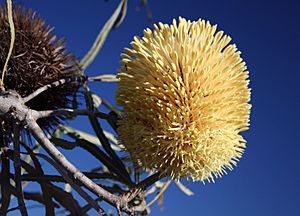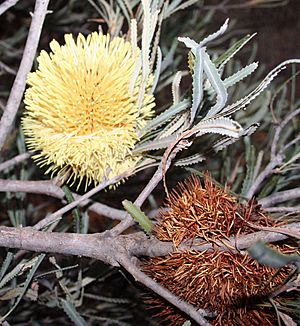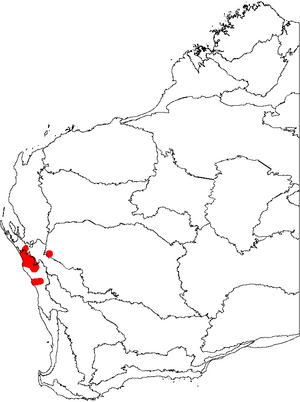Porcupine banksia facts for kids
Quick facts for kids Porcupine Banksia |
|
|---|---|
 |
|
| Scientific classification | |
| Kingdom: | |
| (unranked): | |
| (unranked): | |
| Order: | |
| Family: | |
| Genus: | |
| Species: |
B. lindleyana
|
| Binomial name | |
| Banksia lindleyana Meisn.
|
|
The Porcupine Banksia (Banksia lindleyana) is a cool woody shrub that belongs to the Banksia family, called Proteaceae. It usually grows as a small bush, about 1 meter (3 feet) tall. It has long, narrow leaves with jagged edges, and bright yellow, oval or round flower spikes.
This plant blooms in late summer. After the flowers fade, the spikes turn brown and then grey. They can grow up to 70 seed pods, which hold the seeds. You can find the Porcupine Banksia near Kalbarri, Western Australia, growing in sandy soil. This plant is super important because many birds and animals visit its flowers to help spread pollen!
Contents
What Does It Look Like?
The Porcupine Banksia can grow up to 3 meters (10 feet) tall. When it's young, its branches are covered in soft hairs. As it gets older, these hairs fall off, and the plant develops cracked grey bark.
Its leaves are long and thin, usually about 4 to 13 centimeters (1.5 to 5 inches) long and less than 1.5 centimeters (0.5 inches) wide. They have jagged edges and a rounded tip. Young leaves are also hairy, but they lose their fuzz as they grow, except for tiny pits on the underside.
The Porcupine Banksia flowers from January to March. Its bright yellow flowers grow in a special Banksia flower spike. These spikes are oval or round, about 5 to 9 centimeters (2 to 4 inches) long. They grow on short side branches. After the flowers bloom, the styles (parts of the flower) stay on, making the old flower spike look hairy. These spikes can hold up to 70 seed pods, and each pod has two small winged seeds.
How Was It Named?
The Porcupine Banksia, or Banksia lindleyana, was first officially described in 1855 by a scientist named Carl Meissner. He used plant samples collected by James Drummond a few years earlier near the Murchison River.
The name lindleyana was given to honor John Lindley, another important botanist. Over the years, scientists have studied and rearranged how Banksia plants are grouped. This helps them understand how different species are related to each other.

Here's a simplified look at where B. lindleyana fits in the Banksia family tree:
- Banksia
- B. subg. Isostylis (3 species)
- B. elegans
- B. subg. Banksia
- B. ser. Tetragonae (4 species)
- B. ser. Lindleyanae
- B. lindleyana
- B. ser. Banksia (12 species)
- B. baueri
- B. lullfitzii
- B. attenuata
- B. ashbyi
- B. coccinea
- B. ser. Prostratae (8 species)
- B. ser. Cyrtostylis (4 species)
- B. ser. Ochraceae (3 species)
- B. ser. Grandes (2 species)
- B. ser. Salicinae (11 species)
- B. ser. Spicigerae (7 species)
- B. ser. Quercinae (2 species)
- B. ser. Dryandroideae (1 species)
- B. ser. Abietinae (15 species)
More recently, scientists have used DNA to figure out how Banksia species are related. These studies suggest that the Porcupine Banksia is closely related to plants like the Firewood Banksia (B. menziesii), Ashby's Banksia (B. ashbyi), and B. sceptrum.
Where Does It Live?
The Porcupine Banksia mostly grows on the Geraldton Sandplains. This area is north of Geraldton and stretches towards Shark Bay. There's also one group of these plants found further inland, on the western edge of the Murchison region.
It likes to grow in shrubland areas, especially in deep yellow sand. You can find it in the valleys between coastal sand dunes and also on flat sandy plains further away from the coast.
Growing Your Own Porcupine Banksia
The Porcupine Banksia is a great plant for gardens because of its pretty flowers and interesting woody seed cones, which can even be carved! It grows best in a sunny spot with deep, sandy soil that has some lime in it. It does well in soils like those found in Perth, Australia, but might not grow as well in cooler places.
This plant grows slowly. It takes about 6 to 8 years for a plant grown from seed to start flowering. The seeds don't need any special treatment to sprout, and they usually germinate (start growing) in about 23 to 39 days.


